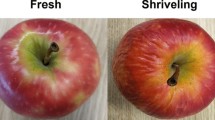Summary
Discs of 1 mm or more in thickness from potato tubers stored at 0 C showed a higher rate of oxygen uptake both in water and in 0.25 M sucrose than corresponding discs from tubers stored at 12.8 C. Tissue from tubers stored at O C was more susceptible to injury from cutting and hypotonicity than tissue from tubers stored at 12.8 C. The enhanced respiratory activity of tissue from cold-stored tubers could not be explained by a greater supply of respiratory substrate or by qualitative differences in respiration. Dinitrophenol induced a marked increase in oxygen uptake in tissue from tubers stored at 12.8 C both in water and in 0.25 M sucrose, but induced no increase in oxygen uptake in tissue from tubers stored at 0 C when incubated in water and only a limited increase when this tissue was incubated in 0.25 M sucrose. Similar to dinitrophenol, incubation at 35 C revealed the structural weakness and susceptibility to damage from hypotonicity of the tissue from tubers stored at O C. After overnight aerobic incubation, discs from tubers stored at O C were not capable of developing the high state of metabolic activity attained by the discs from tubers stored at 12.8 C. Salt leakage from tissue of tubers stored at 0 C was several-fold greater both in water and in 0.25 M sucrose than leakage from tissue from tubers stored at 12.8 C. Salt leakage from tissue from cold-stored tubers was markedly lower in 0.25 M sucrose than in water, but the leakage was still greater than that from tissue from tubers stored at 12.8 C. The different behavior of the tissue from cold-stored tubers may result from physiological changes in the tuber which enable it to withstand prolonged cold storage.
Resumen
Discos de 1 mm o más de espesor obtenidos de tubérculos de papa, almacenados a 0 C, tuvieron una tasa más alta de absorción de oxígeno, tanto en agua como en una solución de 0.25 M de sucrosa, que discos correspondientes almacenados a 12.8 C. El tejido de los tubérculos almacenados a 0 C fué más susceptible al daño causado por la cortadura y a la hipotonicidad que el tejido de los tubérculos almacenados a 12.8 C. La elevada actividad respiratoria del tejido obtenido de tubérculos almacenados al frío no se pude explicar por un mayor abastecimiento de materias respirables o por diferencias cualitativas en la respiración. Dinitrophenol causó un incremento notable en la absorción de oxígeno en tejido obtenido de tubérculos almacenados a 12.8 C tanto en agua como una solución de 0.25 M de sucrosa, pero no produjo incremento alguno en absorción de exígeno en tejido obtenido de tubérculos almacenados a 0 C, incubados en agua, y produjo solamente un incremento limitado cuando este tejido fué puesta en una solución de 0.25 M de sucrosa. Como en el caso de dinitrophenol, incubación a 35 C manifestó una debilidad estructural y susceptibildad al daño, causada por hipotonicidad del tejido obtenido de tubérculos almacenados a 0 C. Después de una noche de incubación aeróbica, discos de tubérculos almacenados a 0 C no fueron capaces de dessarrollar un estado de actividad metabólica tan alta coom la manifestada por los discos de tubérculos almacenados a 12.8 C. La pérdida de sales por el tejido obtenido de tubérculos almacenados a 0 C fué mucho más grande tanto en agua como en la solución de 0.25M de sucrosa que la pérdida por el tejido obtenido de tubérculos almacenados a 12.8 C. La pérdida de sales del tejido de tubérculos almacenados al frío fué notablemente más baja en la solución de 0.25M de sucrosa que en agua, pero pérdida era aun así más grande que la pérdida sostenida por el tejido de tubérculos almacenados a 12.8 C. El comportamiento diferente del tejido de tubérculos almacenados al frío puede ser causado por cambios fisiológicos en el tubérculo, los cuales lo hacen capaz de sobrellevar un prolongado almacenamiento al frío.
Similar content being viewed by others
Literature Cited
Craft, C. C. 1963. Respiration of potatoes as influenced by previous storage temperature. Amer. Potato J. 40: 289–298.
Hopkins, E. F. 1927. Variation in sugar content in potato tubers caused by wounding and its possible relation to respiration. Botan. Gaz. 84: 75–88.
Johnstone, G. R. 1925. Effect of wounding on respiration and exchange of gases. Botan. Gaz. 79: 339–340.
Laties, G. G. 1957. Respiration and cellular work and the regulation of the respiration rate in plants p. 215–299.In Survey of Biol. Prog. III. Academic Press Inc., New York.
Laties, G. G. 1962. Controlling influence of thickness on development and type of respiratory activity in potato slices. Plant Physiol. 37: 679–690.
Miller, L. P., J. D. Guthrie and F. E. Denny. 1936. Induced changes in respiration rates and time relations in the changes in internal factors. Contr. Boyce Thompson Instit. 8: 41–61.
Steward, F. C. W. E. Berry, C. Preston and T. K. Ramamurti. 1943. The absorption and accumulation of solutes by living plant cells. X. Ann. Bot. 7: 221–260.
Author information
Authors and Affiliations
Rights and permissions
About this article
Cite this article
Craft, C.C. Respiration of potato tissue as influenced by previous storage temperature of the tubers. American Potato Journal 44, 174–181 (1967). https://doi.org/10.1007/BF02893117
Accepted:
Issue Date:
DOI: https://doi.org/10.1007/BF02893117




